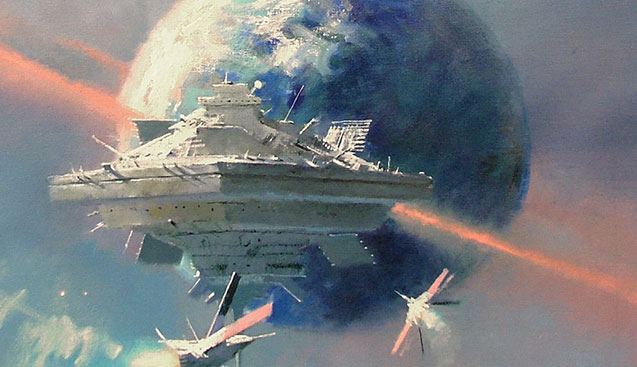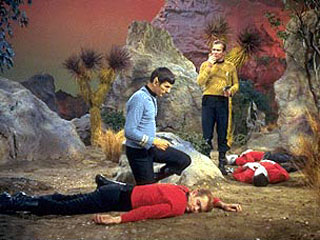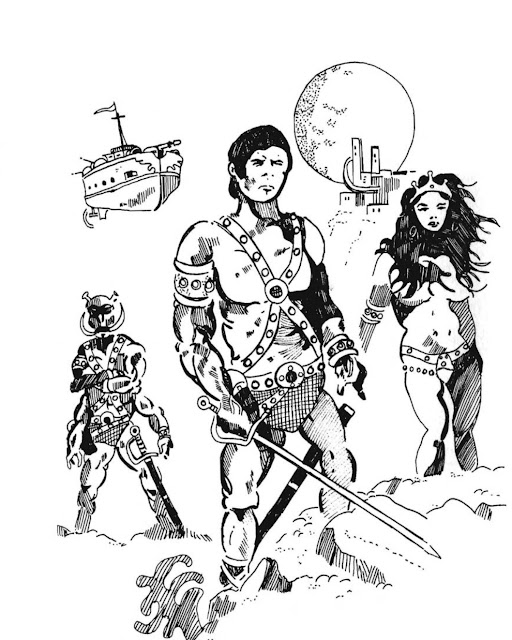Star Probe Game Scale & Turn Steps
I have not posted much for Star Probe because of so much happening in my life, but now is the time to get a good game up and running again, I will thus begin a review of rules for first Star Probe and then the later Star Empire. It is important to understand Star Probe and Star Empires are very abstract games as they are based on large strategic and tactical war gaming. Players are building empires through exploration, trade, colonization and conquest. Many of these kinds of games were actually played by people through the mail system with one player acting as the referee. I am setting up a game for my family... making ship markers and such, so more to follow on that. My hope is these posts will allow interested gamers to play these games again.
As stated in previous posts for the hero’s journey to occur in these games a combination of Chainmail and OD&D type rules appear to have been used. Temple of the Frog from the Blackmoor D&D supplement is really the effect of aliens ending up in D&D from Star Empires. Empire of the Petal Throne is another sci-fi role playing possible resource from this time period and is based on D&D with some significant changes. In addition for a very short period of time Warriors of Mars was also available as well. Latter Star Frontiers was developed and draws heavily on Star Probe and Star Empires ship movement rules for its space craft. Star Probe and Star Empires use randomizer chits or D&D dice d4, d6, d8, d10, d12, and d20. To use the chits see my blog post Dice and Randomizers from November 2017.
Star Probe and Star Empire Game Scale
Strategic Scale
Time: 1 Turn represents a period of 1 Month
Space: Each inch or hex on the Star Mao represents 5 light years
Tactical Scale
For battles between ships
Time: Each battle turn will last a period of a day.
Space: Each inch on the battle surface represents 5000 miles. Thus if your velocity is 10 you will cover 50000 miles in a day.
Battle Surface: This is a floor or a gridded playing surface on which playing pieces are placed and maneuvered to simulate combat.
Playing pieces should be 1/2” squares with the front of the ship clearly indicated. The picture is of a triangular shape arrow like so front is clear.
Turn Procedure:
A. Before play commences, players must do the following
1. Determine Order of Movement
2. Each player must outfit his ship
Each player, in turn, will then:
B. Move
1. Make a hyperspace jump
2. Check for hazards and malfunctions
C. When a star system has been reached
1. Use the Exploration Matrix
2. Consult the Conflict Matrix
D. If exploration reveals a Class 1 System
1. Determine the race and Techno-Social Level of the intelligent life form inhabiting the system.
2. Consult the Race Versus Race Table
3. Negotiate with natives using the Negotiation Matrix if successful record Megaron and go immediately to step B. If negotiations fail go to 4.
4. Negotiate again as in 3 or leave the system go to B. If second attempt at negotiations fails go to 5.
5. The natives attack go to section on Hostile Actions.
E. If exploration reveals Class 2-5 systems or there is “no result”
1. If in step C.2. and a T has resulted consult the Lifeform Matrix.
2. Each additional two months that you remain in a system the Conflict Matrix and if trouble (T) occurs.
3. Record the Megaron gain, revert to step B.
F. When Leaving a system always revert to step B.
Initial Set Up
The players will determine who moves first and select his ship.
1. Each of the players will select two dice and roll them adding the resulting numbers together for a total. (The type of dice is not specified, I use 2d6)
2. After the order of move has been determined the players will select which of the two possible ships he wants to use. Explorer I or Explorer II. The number of players will determine how many Explorer IIs are available. An odd number of players will result in a greater number of Explorer IIs. Example: 7 players will result in 3 Explorer I ships and 4 Explorer II ships being available.
3. After the above is done players must outfit their ships.
NOTE: players should agree upon rules to be followed before play starts to avoid argument. This is sound advice as house rules have always existed in gaming.
The Space Ships
Star Probe has three basic ships available for play. They are Explorer I, Explorer II and the Warship. Tech level of the player determines the abilities of the ships.
Terminology
Attack: This is the amount of damage your ship does. Unit used is Megaron.
Screen Value: This is how much damage the screens will absorb before collapsing from overload, in Megarons. Once the screen collapses your ship’s hull will take damage. Note every turn your ship is not hit the screens regain 1 point. However if the screen generators are destroyed the above does not hold true, your repair crew must repair them. If a hit of 3 Megarons destroyed your generators it will take 3 turns to repair them. Also damage is culumative as far as repairs are concerned.
Attack Range: The number of hexes you may fire beam weapons.
Acceleration Factor: This defines the amount by with your ship may increase or decrease its speed and turn.
Hyper-Space Jump Distance: The number of hexes your ship may transverse the Star Map in a 1 month turn, where 1 hex is 5 light years. Thus a 3 means your ship can go three hexes or 15 light years. Jump time is almost instantaneous it is the programming of the jump that takes 1 month. The crew must calculate and locate 6 fixed points to effect a jump.
Hull Value: The amount of damage the hull of the ship can take before falling apart.
Cargo Hold: Each cargo hold as 10 units of cargo space... thus a hold of 2 means your ship can hold 20 units.
WARSHIPS
Tech Level VI Tech Level VII Tech Level VIII
Attack 3 Attack Range 6 A 5 AR 7 A 7 AR 8
Screen Value 5 Acceleration Factor 2 SV 10 AF 2 SV 15 AF 3
Jump Distance 0 Hull Value 30 JD 3 HV 35 JD 5 HV 40
EXPLORER I EXPLORER II
A 3 AR 7 A 2 AR 6
SV 7 AF 3 SV 4 AF 3
JD 3 HV 25 JD 4 HV 20
Cargo Hold 1 CH 2
HIT LOCATION AMOUNT OF DAMAGE POSSIBLE
Attack Value 10
Attack Range Value Listed
Screen Value Value Listed
Acceleration 10
Jump Drive 10
Hull Value Value Listed
I will be making something similar to the Star Frontiers Knight Hawks Chits but maybe a bit more tactile to get us started.
Outfitting The Ships
The next step is to outfit your expedition. To do this your “department” or “ backers” will give you a grant of 35 Megarons. With this 35 Megarons you will outfit and crew your ship. Ships can hold a maximum of 2500 personnel. The following are the items you can purchase in terms of Megarons the monetary unit for stellar affairs.
Naval Personnel: To run your ship safely you will have to buy 1000 of these at a cost of 5 Megarons. For every 200 this amount your chance of Malfunction goes up by 10% in the Space Hazard section.
A ship will run with no crew for 2 jumps. After that it is a derelict lost in space.
Supplies: Supplies are necessary to feed your crew and maintain your ship at peak efficiency. They cost 2 Megarons per year’s worth per 1250 personnel. Thus if you plan to be out for 3 years for a ship crewed with 1250 staff would cost 6 Megarons but a ship with a crew of 1251-2500 would cost 12 Megarons.
Speciality Teams: Two basic Teams are Contact and Scientific. Contact teams are used to establish communication with any intelligent life firms found in a system. Scientific teams are used to identify any non- inhabited system and discover any specialized devices. Each team cost 2 Megarons. These teams are used to create your Survey Crew. Survey Crews are created by putting a combination of Scientific and Contact teams together. The first Survey Crew must be created by 4 such teams with both type of teams in it... it could be 50/50 or 1 team of one kind and then 3 of the other. Once you have the first Survey Crew of 4 teams, you can organize the remaining teams into crews of less than 4 teams as long as you have at least one of each team type in the crew. As long as you have at least one of each team in your Survey Crew you will be allowed to pick an exploration mode for your Survey Crew.
First In Team: This unit combines all the functions of the of the Survey Crew. Cost 7 Megarons. Unless Option 1 is used, players can only have one such team. Option 1: First In Teams are noted for unruliness so the commander must be able to control them. Roll d20 and see chart...
Numbers Drawn 1-3 4-9 10-15 16-18 19 20
Teams May Have 0 1 2 3 4 5
Marine Groups: These units cost 1/2 Megarons each and consist of combat trained professionals. They provide security for your teams while they are exploring the system. Thus if loses are incurred while exploring they are subtracted from the Marine Groups first.
Repair Crew: Repair Crews are used to repair damage to the ship’s components during battle. Each repair crew can repair 1 Megaron of damage per battle turn. They may not fix damage to ship’s structure. The cost 5 Megarons each.
Missile Salvos: They May purchased at a cost of 1 Megaron per 5 Salvos. Also for each 5 Salvos or part there of you must provide 1 unit of cargo hold space to hold them. Unless Option 2 is used these salvos are used only for space battles or support actions.
Option 2 Blast The Natives: Each missile salvo has a 5% chance of causing the native population to submit. The basic chance is multiplied by the difference between your TSL and the native TSL.
Negotiation Modes: These consist of goods and information that can be used for trade or barter purposes with intelligent races of the system. They cost 1/2 Megaron and are coded numerically 1-20. As you use them you cross them off. Every 5 Negotiation Modes or part there of use 1 Unit of Cargo Hold space.
Hyper-Space Fuel Slugs: This item propels your ship at speeds faster than light. Each slug costs 1/4 Megaron. The engines of any ship are designed to contain 12 slugs. Each additional 4 slugs costs 1 unit of cargo hold space to store.
How you configure your Survey Crews will effect out comes in exploration. Of course some players maybe more conquest orientated.
Typical Government Approved Outfitting Of A Ship
1000 Naval Personnel. 5 M
1 Year’s Supply Rations 4 M
2 Contact & 2 Scientific 8 M
6 Marines 3 M
10 Negotiation Modes 5 M
8 Hyper-Space Slugs 2M
1 First Team In. 7M
5 Missile Salvos 1M
Total 30 M
Now you should have a ship ready to start exploring and forging an empire... more to follow.
If you have ever played Star Frontiers Knight Hawks Rules some of these rules will already seem very familiar to you especially concerning ship terminology. When we get into movement the similarities will continue.
Happy Gaming...in Quarantine Zoom or do some other platform and get wargaming with your friends!
Rules and Resources
The Star Probe/Star Empires Map
Randomizer Chits





















Comments
Post a Comment